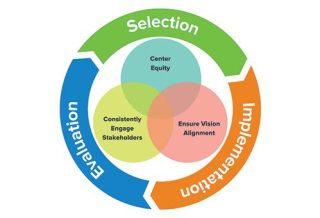FOCUS
Materials matter
Instructional materials + professional learning = student achievement
By David Steiner
Categories: College- and career-ready standards, Instructional materials/curriculumDecember 2018
Vol. 39 No. 6
A number of research summaries over the last few years have brought attention to the impact that high-quality instructional materials have on student learning. The U.S. Department of Education’s What Works Clearinghouse, which produces summaries of rigorous research, has identified a number of effective curricula with large effect sizes on students’ reading, math, and science learning (e.g. Borman, Dowling, & Schneck, 2008; Hirschhorn, 1993; Smith et al., 1993; Zucker, Tinker, Staudt, Mansfield, & Metcalf, 2008).
In fact, studies show that selecting a high-quality curriculum can have a bigger impact than a number of other popular interventions such as decreasing class size and offering merit pay to teachers (Boser, Chingos, & Straus, 2015; Koedel & Polikoff, 2017; Whitehurst, 2009). One study found a spread between the impact of two different math textbooks that amounted to a 10-percentile point gain in achievement (Kane, Owens, Marinell, Thal, & Staiger, 2016).
“The positive effects of high-quality curriculum shouldn’t perhaps surprise us.” – Ashley Berner, Johns Hopkins University
The cumulative impact of high-quality curriculum can be significant. Most research studies focus on the impact of a curriculum over one or two years. But over time, even a small annual effect can compound to make a big impact. Daniel Hirschhorn’s longitudinal study (1993) found that students who were taught using a high-quality math curriculum for four consecutive years (grades 7-10) outpaced comparison students by a margin of 23 percentile points — an effect that amounts to four additional years of learning. When extrapolated across an entire class, grade, or school, such impacts could prove transformative.

INTERNATIONAL EVIDENCE
Because most state standards, including the Common Core, and most state assessments, including PARCC and Smarter Balanced, are largely skills-focused, many curricular materials in the United States, especially in English language arts, focus on skills rather than on knowledge.
This is unsurprising, given that it has been difficult to agree on which key texts students should read or which areas of knowledge they should master, particularly in middle and high school.
But studies of educationally top-performing countries across the globe indicate that one of the very few characteristics they share is a high-quality, content-rich curriculum. The most extensive study, performed by a research team at Common Core Inc., found that a comprehensive, content-rich curriculum was the salient feature in nine of the world’s highest-performing school systems as measured by the Programme for International Student Assessment (PISA).
Despite the vast cultural, demographic, political, and geographic diversity of Finland, Hong Kong, South Korea, Canada, Japan, New Zealand, Australia, the Netherlands, and Switzerland, their educational systems all shared an emphasis on content-rich curriculum and commensurate standards and assessments (Common Core, 2009).
Ashley Berner, deputy director of the Johns Hopkins Institute for Education Policy and assistant professor in the School of Education at Johns Hopkins University, has investigated international best practices. “The positive effects of high-quality curricula shouldn’t perhaps surprise us,” she writes. “Most democracies around the world require all schools to teach a common body of knowledge, and a comprehensive, content-rich curriculum is a signature feature of high performers” (Berner, 2018).
Berner references OECD’s 2013 report on excellence and equity, which found that the most equitable countries instruct all students, not merely those deemed “gifted,” in high-level mathematics. It is instructive to look at two systems in particular: the Netherlands and Alberta, Canada. These systems fund a wide variety and number of schools, require them all to follow the same sequenced curricula, and are among the world’s most equitable and high-performing school systems (OECD, 2013).
We also have evidence of what happens when a nation moves in the opposite direction, giving up its national curriculum. In Knowledge Matters, E.D. Hirsch reports data from France that show the steep decline of academic results from children of every economic background in the years after that country abandoned its national, content-rich curriculum (Hirsch, 2016).
COST DOES NOT PREDICT QUALITY
Surprisingly, effective curricula cost, on average, no more than weak curricula. When it comes to math curricula in the early grades, there is little relationship between cost and quality of instructional products.
Boser and colleagues (2015) examined six pairs of elementary math curricula, each of which had a lower- and a higher-quality version. They found that switching from the lower- to the higher-quality product would cause districts to incur “not much of a cost.”
In fact, prices do not vary widely across products, with the most expensive product in the same government-sponsored study costing only $13 per student more than the least-expensive product. If anything, the higher-quality products tend to cost less, and, in some instances, the most expensive curriculum was among the least effective and the least expensive was among the most effective (Boser et al., 2015).
Among the less-expensive curricula are those made available online in an open educational resources format. In this instance, the basic curriculum is available for free downloading, with the costs restricted to printing and, in some cases, to supplemental material.
Engage NY, for instance, is a widely used open educational resource available for free (New York State Education Department, n.d.). In 2015, Duval County, Florida, began to use Engage NY districtwide. An internal audit shows that the district saved more than $10 million over three years by using open educational resources and printing the materials rather than using published curricula (Hoskinson, 2015).
At the same time, the academic results from Duval County since the introduction of the Engage NY curricula have been promising. As of 2018, student proficiency in many academic areas has risen (Duval County Public Schools, 2018).
TEACHERS FREQUENTLY DEVELOP THEIR OWN MATERIALS
Yet despite all this research, individual teachers self-select many of their instructional materials, and, as a result, most students are taught — at least in part — through idiosyncratic curricula that are not defined by school districts or states.
As I report in my own review of the evidence, teachers report using a variety of instructional materials from a wide array of sources: formal, published curricula and informal, online lessons; self-developed and district-selected materials; and those aligned to standards or not (Steiner, 2017).
One study of teachers in five states found that 80% of English language arts teachers and 72% of math teachers reported using materials they or their colleagues developed on at least a weekly basis, and they used other materials less frequently than once a week (Kane et al., 2016).
Another similar sudy found even higher rates for teachers using materials they developed or found themselves: 83% of elementary math teachers, 87% of secondary school math teachers, 90% of elementary English language arts teachers, and 85% of secondary school English language arts teachers (Kaufman et al., 2017).
Teachers clearly rely on a wide variety of online resources, with Google, Pinterest, and Teachers Pay Teachers leading a list compiled by research organization RAND (Opfer, Kaufman, & Thompson, 2016). The issue is not with the fact that the resources are online — such materials can be strong, and even downloading materials for a single lesson can add supplemental value (Jackson & Makarin, 2018). Rather, the issue is that when teachers create their own lessons too much of the time, students may not get the benefits of a fully sequenced, coherent learning experience.
A recent study found that materials created or selected by teachers were generally less likely than those provided by their district to meet academic standards appropriate to the grade level in English language arts and math (TNTP, 2018).
On average, teacher-created or selected materials aligned to academic standards 20% of the time, while district-adopted materials aligned 34% of the time. When teachers reported that their assignments came from high-quality district offerings, student assignments were grade-appropriate 53% of the time.
Schools of education across the United States do not prepare future teachers for the many skills required to become effective curricula designers. Teachers and their students deserve access to effective, high-quality curriculum materials, rather than asking teachers to cobble together lessons largely without any professional training or support.
PROFESSIONAL LEARNING IS ESSENTIAL FOR IMPLEMENTING CURRICULA
Providing high-quality materials to teachers is not enough, however. While stronger instructional materials make a real difference, that difference is magnified by matching it with professional learning.
Indeed, research suggests that over half of the possible impact of shifting to a stronger curriculum is lost if the transition does not include a shift in teacher practice that specifically supports the new materials (Taylor et al., 2015).
One can make a clear inference that professional development that guides teachers to optimize their use of new curricula must be an essential part of any instructional materials-oriented school-level transitions.
What would it mean for teacher preparation programs to properly prepare teachers to use high-quality curricula? A University of Washington professor quoted in a report from Learning First explained how the university’s teacher preparation program is starting to address this issue directly:
“The teachers we work with as preservice teachers are working with anywhere from seven to eight different curriculum materials in their placement schools. So we have to very concertedly help them learn how to read the curriculum materials they get and how to adapt them to be in line with what they learned through the university. … It’s not true that just because you’ve learned how to elicit and respond to student thinking in the field-based methods course that you’ll do that in your student teaching if you haven’t learned how to use the curriculum materials that you’re given” (Toon & Jensen, 2017).
This is a positive step, but professional learning on curriculum implementation shouldn’t end when a teacher begins his or her first classroom job. Teachers already on the job need the same skills so they can become smart users of the curriculum materials provided by their districts or schools, especially because it’s not uncommon for schools to change curricula.
Using the curriculum materials effectively includes being able to distinguish high- and low-quality materials, knowing how to analyze whether the materials align with achievement standards, and practicing how to use and adapt materials in the classroom (Toon & Jensen, 2017).
It is encouraging that U.S. education policymakers are starting to take steps in the right direction. Under John White’s leadership, Louisiana’s Department of Education has partnered with its teachers successfully to support and incentivize the use of high-quality materials (Kaufman, Thompson, & Opfer, 2016; Pondiscio, 2017).
National leadership organizations such as Chiefs for Change (2017, 2018) are now on the record as advocating for the shift to strong curricula. And we are seeing more reports and respected education publications bringing attention to best practices (e.g. The Aspen Institute, 2018; Instruction Partners, 2017). All of these efforts point to a simple but powerful message: Curriculum quality matters.
References
Berner, A. (2018, August 2). Curriculum and education policy [Web log post). Available at https://edexcellence.net/articles/curriculum-and-education-policy.
Borman, G.D., Dowling, N.M., & Schneck, C. (2008). A multisite cluster randomized field trial of Open Court Reading. Educational Evaluation and Policy Analysis, 30(4), 389-407.
Boser, U., Chingos, M., & Straus, C. (2015). The hidden value of curriculum reform. Washington, DC: Center for American Progress.
Chiefs for Change. (2017, August 10). Hiding in plain sight: Leveraging curriculum to improve student learning. Washington, DC: Author.
Chiefs for Change. (2018, June 6). Statement on the need for high-quality curriculum. Washington, DC: Author.
Common Core. (2009). Why we’re behind: What top nations teach their student but we don’t. Washington, DC: Author.
Duval County Public Schools. (2018, June 27). Duval County Public Schools gain 14 overall points, close in on “A” grade. Jacksonville, FL: Author.
Hirsch, E.D. (2016). Why knowledge matters: Rescuing our children from failed educational theories. Cambridge, MA: Harvard Education Press.
Hirschhorn, D.B. (1993). A longitudinal study of students completing four years of UCSMP mathematics. Journal for Research in Mathematics Education, 24(2), 136-158.
Hoskinson, C. (2015, June 23). Online Common Core courses to save Duval schools $10M over two years. Available at https://news.wjct.org/post/online-common-core-courses-save-duval-schools-10m-over-two-years.
Instruction Partners. (2017). What does it take to implement a strong curriculum effectively? Part one: What do we know about the experience of schools implementing rigorous curricula? Nashville, TN: Author.
Jackson, K. & Makarin, A. (2018). Can online off-the-shelf lessons improve student outcomes? Evidence from a field experiment. American Economic Journal: Economic Policy, 10(3), 226-254.
Kane, T., Owens, A., Marinell, W., Thal, D., & Staiger, D. (2016). Teaching higher: Educators’ perspectives on Common Core implementation. Cambridge, MA: Center for Education Policy Research, Harvard University.
Kaufman, J.H., Davis, J.S., Wang, E.L., Thompson, L.E., Pane, J.D., Pfrommer, K., & Harris, M. (2017). Use of open educational resources in an era of common standards. Santa Monica, CA: Rand Corporation.
Kaufman, J., Thompson, L., & Opfer, V.D. (2016, September). Creating a coherent system to support instruction aligned with state standards: Promising practices of the Louisiana Department of Education. Arlington, VA: RAND Corporation.
Koedel, C. & Polikoff, M. (2017). Big bang for just a few bucks: The impact of math textbooks in California. Evidence Speaks Reports, 2(5), 1-7.
New York State Education Department. (n.d.). Engage NY. Available at www.engageny.org.
OECD. (2013). PISA 2012 Results: Excellence through equity (Volume II). Paris, France: Author.
Opfer, V.D., Kaufman, J., & Thompson, L. (2016). Implementation of K-12 state standards for mathematics and English language arts and literacy: Findings from the American Teacher Panel. Santa Monica, CA: RAND Corporation.
Pondiscio, R. (2017). Louisiana threads the needle on ed reform: Launching a coherent curriculum in a local-control state. Education Next, 17(4). Available at www.educationnext.org/louisiana-threads-the-needle-ed-reform-launching-coherent-curriculum-local-control.
Smith, L.J., Ross, S.M., Faulks, A., Casey, J., Shapiro, M., & Johnson, B. (1993). 1991-1992 Ft. Wayne, Indiana SFA results. Memphis, TN: Center for Research in Education Policy.
Steiner, D. (2017). Curriculum research: What we know and where we need to go. StandardsWork. Available at https://standardswork.org/wp-content/uploads/2017/03/sw-curriculum-research-report-fnl.pdf.
Taylor, J.A., Getty, S.R., Kowalski, S.M., Wilson, C.D., Carlson, J., & Van Scotter, P. (2015). An efficacy trial of research-based curriculum materials with curriculum-based professional development. American Educational Research Journal, 52(5), 984-1017.
The Aspen Institute. (2018). Improving access to high-quality instructional materials. Washington, DC: The Aspen Institute.
TNTP. (2018). The opportunity myth. New York, NY: Author.
Toon, D. & Jensen, B. (2017). Teaching our teachers a better way: Using K-12 curriculum to improve teacher preparation. Melbourne, Australia: Learning First.
Whitehurst, G. (2009, October). Don’t forget curriculum. Brown Center Letters on Education, 12.
Zucker, A.A., Tinker, R., Staudt, C., Mansfield, A., & Metcalf, S. (2008). Learning science in grades 3-8 using probeware and computers: Findings from the TEEMSS II project. Journal of Science Education and Technology, 17(1), 42-48.
Categories: College- and career-ready standards, Instructional materials/curriculum
Recent Issues
WHERE TECHNOLOGY CAN TAKE US
April 2024
Technology is both a topic and a tool for professional learning. This...
EVALUATING PROFESSIONAL LEARNING
February 2024
How do you know your professional learning is working? This issue digs...
TAKING THE NEXT STEP
December 2023
Professional learning can open up new roles and challenges and help...
REACHING ALL LEARNERS
October 2023
Both special education and general education teachers need support to help...










